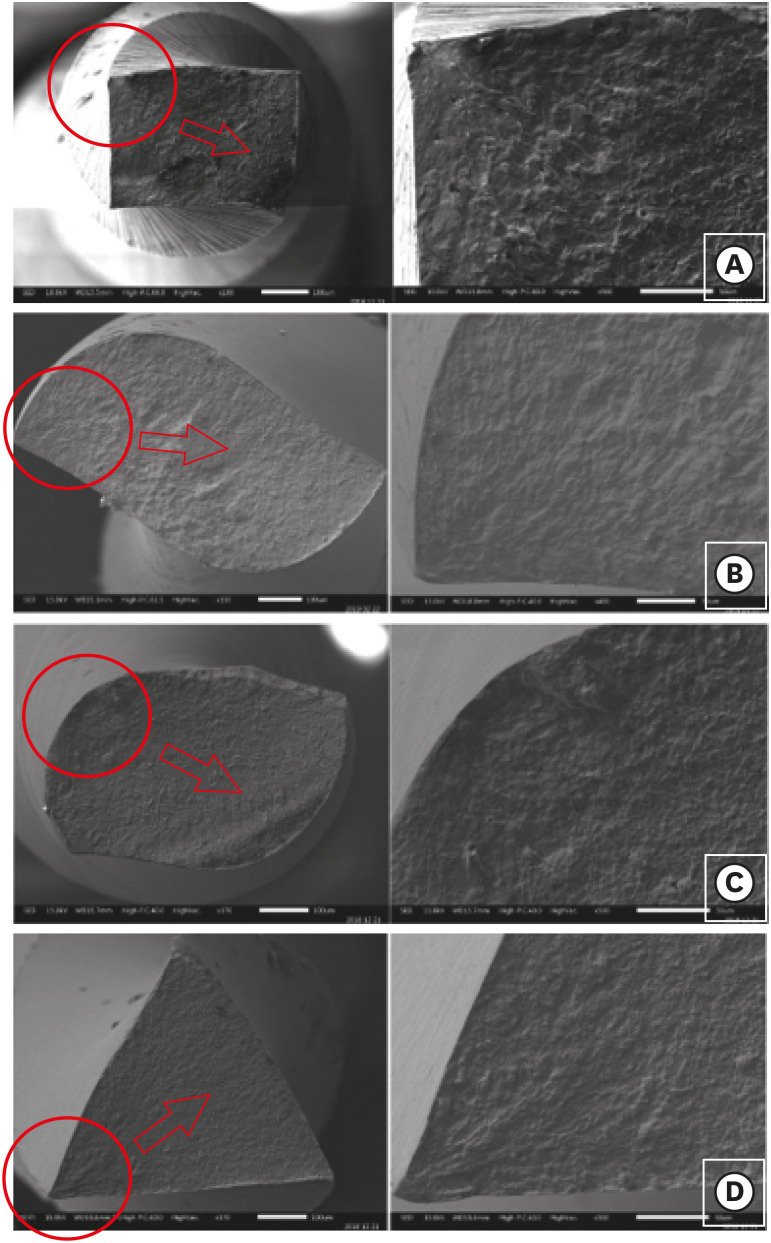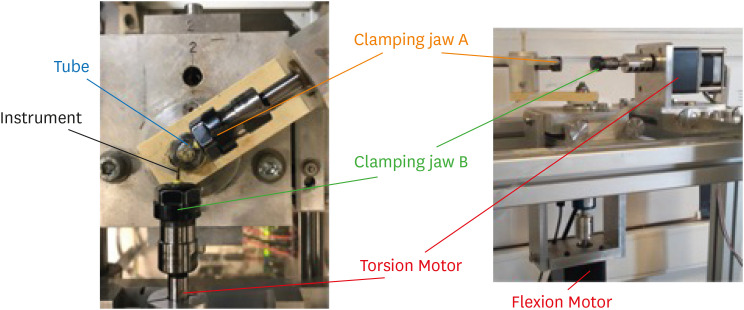1. Neurohr AJ, Dunand DC. Shape-memory NiTi with two-dimensional networks of micro-channels. Acta Biomater. 2011; 7:1862–1872. PMID:
21130189.
2. Frotscher M, Kahleyss F, Simon T, Biermann D, Eggeler G. Achieving small structures in thin NiTi sheets for medical applications with water jet and micro machining: a comparison. J Mater Eng Perform. 2011; 20:776–782.
3. Stoeckel D. Nitinol medical devices and implants. Minim Invasive Ther Allied Technol. 2000; 9:81–88.

4. Oshida Y. Bioscience and bioengineering of titanium materials. 1st ed. Amsterdam, Holland: Elsevier;2007.
5. Thompson SA. An overview of nickel-titanium alloys used in dentistry. Int Endod J. 2000; 33:297–310. PMID:
11307203.

6. Peters OA. Current challenges and concepts in the preparation of root canal systems: a review. J Endod. 2004; 30:559–567. PMID:
15273636.
7. Parashos P, Messer HH. Rotary NiTi instrument fracture and its consequences. J Endod. 2006; 32:1031–1043. PMID:
17055902.

8. Çapar ID, Arslan H. A review of instrumentation kinematics of engine-driven nickel-titanium instruments. Int Endod J. 2016; 49:119–135. PMID:
25630977.

9. Yared G. Canal preparation using only one Ni-Ti rotary instrument: preliminary observations. Int Endod J. 2008; 41:339–344. PMID:
18081803.

10. Franco V, Fabiani C, Taschieri S, Malentacca A, Bortolin M, Del Fabbro M. Investigation on the shaping ability of nickel-titanium files when used with a reciprocating motion. J Endod. 2011; 37:1398–1401. PMID:
21924190.

11. Bürklein S, Hinschitza K, Dammaschke T, Schäfer E. Shaping ability and cleaning effectiveness of two single-file systems in severely curved root canals of extracted teeth: Reciproc and WaveOne versus Mtwo and ProTaper. Int Endod J. 2012; 45:449–461. PMID:
22188401.

12. Mohammadi Z, Soltani MK, Shalavi S, Asgary S. A Review of the various surface treatments of NiTi Instruments. Iran Endod J. 2014; 9:235–240. PMID:
25386201.
13. Aun DP, Peixoto IF, Houmard M, Buono VT. Enhancement of NiTi superelastic endodontic instruments by TiO2 coating. Mater Sci Eng C. 2016; 68:675–680.
14. Lopes HP, Elias CN, Vieira MV, Vieira VT, de Souza LC, Dos Santos AL. Influence of surface roughness on the fatigue life of nickel-titanium rotary endodontic instruments. J Endod. 2016; 42:965–968. PMID:
27080117.

15. Zupanc J, Vahdat-Pajouh N, Schäfer E. New thermomechanically treated NiTi alloys - a review. Int Endod J. 2018; 51:1088–1103. PMID:
29574784.

16. Pereira ES, Peixoto IF, Viana AC, Oliveira II, Gonzalez BM, Buono VT, Bahia MG. Physical and mechanical properties of a thermomechanically treated NiTi wire used in the manufacture of rotary endodontic instruments. Int Endod J. 2012; 45:469–474. PMID:
22188417.

17. Alapati SB, Brantley WA, Iijima M, Clark WA, Kovarik L, Buie C, Liu J, Ben Johnson W. Metallurgical characterization of a new nickel-titanium wire for rotary endodontic instruments. J Endod. 2009; 35:1589–1593. PMID:
19840654.

18. Siu C, Marshall JG, Baumgartner JC. An
in vivo comparison of the Root ZX II, the Apex NRG XFR, and Mini Apex Locator by using rotary nickel-titanium files. J Endod. 2009; 35:962–965. PMID:
19567315.

19. Kaval ME, Capar ID, Ertas H, Sen BH. Comparative evaluation of cyclic fatigue resistance of four different nickel-titanium rotary files with different cross-sectional designs and alloy properties. Clin Oral Investig. 2017; 21:1527–1530.

20. Serafin M, De Biasi M, Franco V, Angerame D.
In vitro comparison of cyclic fatigue resistance of two rotary single-file endodontic systems: OneCurve versus OneShape. Odontology. 2019; 107:196–201. PMID:
30255216.

21. Shen Y, Coil JM, Zhou H, Zheng Y, Haapasalo M. HyFlex nickel-titanium rotary instruments after clinical use: metallurgical properties. Int Endod J. 2013; 46:720–729. PMID:
23330612.

22. Ninan E, Berzins DW. Torsion and bending properties of shape memory and superelastic nickel-titanium rotary instruments. J Endod. 2013; 39:101–104. PMID:
23228266.

23. Topçuoğlu HS, Topçuoğlu G, Akti A, Düzgün S.
In vitro comparison of cyclic fatigue resistance of ProTaper Next, HyFlex CM, OneShape, and ProTaper universal instruments in a canal with a double curvature. J Endod. 2016; 42:969–971. PMID:
27091353.

24. Tobushi H, Nakahara T, Shimeno Y, Hashimoto T. Low-cycle fatigue of Ni-Ti shape memory alloy and formulation of fatigue life. J Eng Mater Technol. 2000; 122:186–191.

25. Shen Y, Qian W, Abtin H, Gao Y, Haapasalo M, Haapasalo M. Effect of environment on fatigue failure of controlled memory wire nickel-titanium rotary instruments. J Endod. 2012; 38:376–380. PMID:
22341078.

26. Vadhana S, SaravanaKarthikeyan B, Nandini S, Velmurugan N. Cyclic fatigue resistance of RaCe and Mtwo rotary files in continuous rotation and reciprocating motion. J Endod. 2014; 40:995–999. PMID:
24935551.

27. Grande NM, Plotino G, Pecci R, Bedini R, Malagnino VA, Somma F. Cyclic fatigue resistance and three-dimensional analysis of instruments from two nickel-titanium rotary systems. Int Endod J. 2006; 39:755–763. PMID:
16948660.

28. La Rosa GR, Palermo C, Ferlito S, Isola G, Indelicato F, Pedullà E. Influence of surrounding temperature and angle of file access on cyclic fatigue resistance of two single file nickel-titanium instruments. Aust Endod J. 2021; 47:260–264. PMID:
33277785.

29. Rubio J, Zarzosa JI, Pallarés A. A comparative study of cyclic fatigue of 10 different types of endodontic instruments: an
in vitro study. Acta Stomatol Croat. 2019; 53:28–36. PMID:
31118530.

30. Cheung GS, Zhang EW, Zheng YF. A numerical method for predicting the bending fatigue life of NiTi and stainless steel root canal instruments. Int Endod J. 2011; 44:357–361. PMID:
21219364.

31. Capar ID, Ertas H, Arslan H. Comparison of cyclic fatigue resistance of novel nickel-titanium rotary instruments. Aust Endod J. 2015; 41:24–28. PMID:
24697976.

32. Elnaghy AM, Elsaka SE. Cyclic fatigue resistance of One Curve, 2Shape, ProFile Vortex, Vortex Blue, and RaCe nickel-titanium rotary instruments in single and double curvature canals. J Endod. 2018; 44:1725–1730. PMID:
30409450.

33. Ye J, Gao Y. Metallurgical characterization of M-Wire nickel-titanium shape memory alloy used for endodontic rotary instruments during low-cycle fatigue. J Endod. 2012; 38:105–107. PMID:
22152631.

34. Shen Y, Zhou HM, Zheng YF, Campbell L, Peng B, Haapasalo M. Metallurgical characterization of controlled memory wire nickel-titanium rotary instruments. J Endod. 2011; 37:1566–1571. PMID:
22000465.

35. Iacono F, Pirani C, Generali L, Bolelli G, Sassatelli P, Lusvarghi L, Gandolfi MG, Giorgini L, Prati C. Structural analysis of HyFlex EDM instruments. Int Endod J. 2017; 50:303–313. PMID:
26864081.
36. Testarelli L, Plotino G, Al-Sudani D, Vincenzi V, Giansiracusa A, Grande NM, Gambarini G. Bending properties of a new nickel-titanium alloy with a lower percent by weight of nickel. J Endod. 2011; 37:1293–1295. PMID:
21846552.

37. Pongione G, Pompa G, Milana V, Di Carlo S, Giansiracusa A, Nicolini E, De Angelis F. Flexibility and resistance to cyclic fatigue of endodontic instruments made with different nickel-titanium alloys: a comparative test. Ann Stomatol (Roma). 2012; 3:119–122. PMID:
23386933.
38. Santos LA, Bahia MG, de Las Casas EB, Buono VT. Comparison of the mechanical behavior between controlled memory and superelastic nickel-titanium files via finite element analysis. J Endod. 2013; 39:1444–1447. PMID:
24139271.

39. Pereira ES, Viana AC, Buono VT, Peters OA, Bahia MG. Behavior of nickel-titanium instruments manufactured with different thermal treatments. J Endod. 2015; 41:67–71. PMID:
25112810.

40. Goo HJ, Kwak SW, Ha JH, Pedullà E, Kim HC. Mechanical properties of various heat-treated nickel-titanium rotary instruments. J Endod. 2017; 43:1872–1877. PMID:
28951028.

41. Soares RG, Lopes HP, Elias CN, Vieira MV, Vieira VT, de Paula CB, Alves FR. Comparative study of the mechanical properties of instruments made of conventional, M-wire, R-phase, and controlled memory nickel-titanium alloys. ENDO. 2017; 11:271–277.
42. Zhou HM, Shen Y, Zheng W, Li L, Zheng YF, Haapasalo M. Mechanical properties of controlled memory and superelastic nickel-titanium wires used in the manufacture of rotary endodontic instruments. J Endod. 2012; 38:1535–1540. PMID:
23063231.

43. Capar ID, Kaval ME, Ertas H, Sen BH. Comparison of the cyclic fatigue resistance of 5 different rotary pathfinding instruments made of conventional nickel-titanium wire, M-wire, and controlled memory wire. J Endod. 2015; 41:535–538. PMID:
25510316.

44. Pedullà E, Lo Savio F, Boninelli S, Plotino G, Grande NM, Rapisarda E, La Rosa G. Influence of cyclic torsional preloading on cyclic fatigue resistance of nickel - titanium instruments. Int Endod J. 2015; 48:1043–1050. PMID:
25353957.

45. Palma PJ, Messias A, Cerqueira AR, Tavares LD, Caramelo F, Roseiro L, Santos JM. Cyclic fatigue resistance of three rotary file systems in a dynamic model after immersion in sodium hypochlorite. Odontology. 2019; 107:324–332. PMID:
30542934.

46. Topçuoğlu HS, Topçuoğlu G, Kafdağ Ö, Balkaya H. Effect of two different temperatures on resistance to cyclic fatigue of one Curve, EdgeFile, HyFlex CM and ProTaper next files. Aust Endod J. 2020; 46:68–72. PMID:
31410934.







 PDF
PDF Citation
Citation Print
Print




 XML Download
XML Download